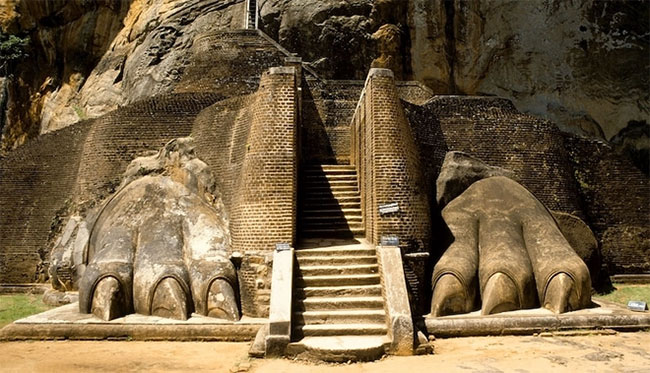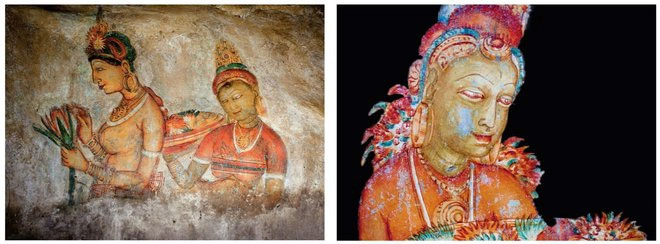Built in the fifth century, Sigiriya Fortress, also known as the “Lion’s Rock” of Sri Lanka, captured the attention of British archaeologists in the 1800s.
Perched on a significant rock outcrop in the forests of central Sri Lanka, Sigiriya still stands majestically as it did when it was first constructed by a notorious tyrant king in the fifth century AD. Also referred to as the Lion Fortress, Sigiriya (recognized as a UNESCO World Heritage Site in 1982) is accessed via a path carved into the rock between the legs of two giant lion statues.
Over time, the fortress was gradually consumed by the jungle, with its entrance becoming familiar only to local villagers. However, its name remained known to outsiders through ancient Buddhist texts. British historians searched for the remnants of Sigiriya in historical writings and rediscovered its architecture, frescoes, and the entire fortress in the 19th century.

The Mahavamsa epic of Sri Lanka tells the story of Prince Vijaya, a descendant of a lion – an animal considered by Sri Lankan culture to be the ancestor of the royal lineage. The prince traveled across Sri Lanka and married Princess Kuveni. From them, the Sinhalese (meaning “belonging to the lion”) were born. The image above shows the remains of the Lion’s Paw Gate at Sigiriya – (Photo SUPERSTOCK/AGE FOTOSTOCK).
Sigiriya was constructed by King Kashyapa I in the fifth century, who ruled the indigenous Sinhalese dynasty – Moriya. The magnificent fortress served as the capital of the Sinhalese kingdom until Kashyapa was defeated in 495 AD.
After Kashyapa, various dynasties rose and fell, shaped by internal power struggles as well as conflicts between the indigenous Sinhalese and invading forces from India.
Many other cities took turns as the capital after Sigiriya, such as Polonnaruwa. However, by the 12th century, overall control of Sri Lanka gradually weakened. The power of the Sinhalese shifted to the southwestern part of the island, leaving the Rajarata region and old administrative centers, including Sigiriya, no longer in use.
Sri Lanka’s position in the Indian Ocean made it vulnerable to European powers seeking to expand their control in the region. By the mid-1500s, the Portuguese exploited the tensions among the ruling elite of Sri Lanka and controlled much of the island.

The architecture of the Lion’s Rock harmoniously combines beauty and utility, clearly seen in the royal gardens of the fortress – (Photo Dea/Age Fotostock).
A century later, the Dutch replaced the Portuguese as the colonial masters, only to be succeeded by the British in the late 1700s. By 1815, the Kingdom of Kandy, the last independent indigenous state on the island, became part of the British Empire.
The rule of the British Empire brought George Turnour – a nobleman, scholar, and passionate historian – to this historically rich land. Turnour worked with a Buddhist monk to translate an ancient chronicle from the fifth century – the Mahavamsa, from Pali into English. Based on this text and others, he identified two ancient capitals: Anuradhapura and Polonnaruwa.
Turnour also studied a later chronicle of Sri Lankan history – the Culavamsa, which recounts the story of King Kashyapa. At the end of the fifth century, this Sinhalese prince assassinated his father, King Dhatusena, and seized the throne. Fearing revenge from his brother, he built the Sigiriya fortress – but it seemed completely futile: His brother, after fleeing to India, returned, defeated Kashyapa, and Sigiriya lost its status as a capital in a short time.

The royal garden located at the western square holds a contrast between the straight lines of design and the curves of nature – (Photo Rober Harding/Age Fotostock).
In 1827, a Scottish officer, Jonathan Forbes, befriended Turnour, and after hearing the story of Kashyapa and the palace, he decided to search for it. In 1831, he set out to where the locals told him he would find the ruins of an ancient city.
His memoir describes, “these ruins are located in a vast forest far from the surrounding plains. As we approached, we could see platforms and galleries carved into the rock. Two members of our group attempted to open some paths, but the stones were dislodged and fell into the dense canopy below“. Unsure if he would find the Sigiriya mentioned in Buddhist texts, Forbes abandoned the expedition.

On the walls of the Lion’s Rock, images of beautiful maidens dancing and carrying offerings on their shoulders – (Photo José Raga/Age Fotostock (left) and Philippe Michel/Age Fotostock (right)).
British climbers eventually discovered this site in 1851 through the survey mission of Harry CP Bell. His survey at the end of the 19th century laid the foundation for all subsequent research.
Bell meticulously identified the layout of Kashyapa’s city as well as the exquisite carvings on the lion’s paws at the entrance, which Forbes could not see.
In addition to the elaborate water gardens at the foot of the rock, Bell’s survey also drew attention to the galleries on the rock face. These were adorned with delicate frescoes that have become some of the most valued artifacts in Sri Lanka’s artistic heritage.


















































